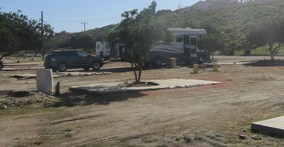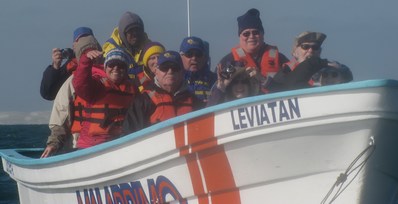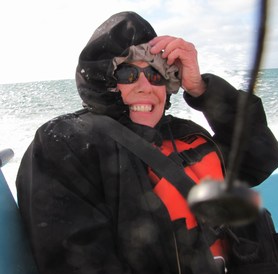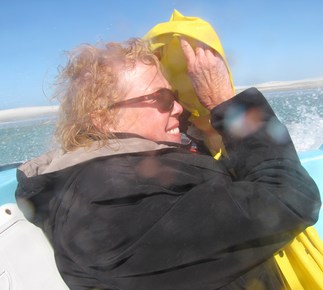Whale Watching & Petting in Mexico -- 2013
Yes, indeed, folks, we actually were able to reach out and touch, pet, stroke, and pat both Mama and baby Gray whales. What a fantastic experience to get so up close and personal with such large mamals.
Neither Linda nor I are really caravan folks, since we like to travel on our own schedule and not be bound by departures dictated by a watch. However, we are both rather wimpy when it comes to traveling far down into Baja, Mexico, without first having been there and learned how and where to go.
However, we were asked by some friends of ours to accompany them on a Fantasy RV caravan tour for the experience of being able to actually pet baby whales. After some careful thinking and counting the pennies in the jar, we agreed to join the caravan for a 13-day adventure from Chula Vista, California, (near San Diego) driving some 400 miles down into Baja Sur, Mexico, and then mostly retracing our journey back up the Baja, and ending up in Santee, California.
We met up with the caravan at a KOA RV park in Chula Vista, California, where we met the Wagon Master husband and wife team, the Tail Gunner husband and wife team, and 17 other couples who would be our companions on the excursion down to Guerrero Negro, Mexico.
Each of the RVs had a large, colorful decal affixed to the front and rear of the RVs, and to the rear of any toads being dragged along on the trip. The Wagon Master was No. 1, the Tail Gunner was No. 2, and the rest of us were assigned a number in alphabetical order of our last names. Linda and Mike were Fantasy No. 9.

Before we departed from Chula Vista, we all exchanged some American dollars for a bunch of Mexican pesos. Most of the tour members exchanged about $500 in US currency and received slightly more than 6000 Mexican pesos. (At the time, the exchange rate for buying pesos was 12.15 pesos per $1 US.) As many of us would discover later, the steep grades, twisty roads, and often very slow speeds caused our rigs to get far less fuel economy than we had figured. (In our case, our gasser pulling our toad was getting only about 4 mpg!)
We were almost surprised, but very relieved and happy, when we were able to get some more pesos from an ATM machine at a bank in Guerrero Negro. I was quite surprised to be able to use my regular Chase ATM card at a Mexican bank. Although all the ATM directions were in Spanish, I was able to select my withdrawal from either my checking or savings account. The ATM machine charged us about a $2.75 service fee to use the ATM machine. (But, we didn't have to go through the hassle of going inside the bank and trying to use our regular VISA or Master Cards.) Seeing my savings account balance in pesos made me feel like a rich man! (Yeah, sure.)
Not all of the RVs had working CBs, so the Wagon Master used both CB, Channel 10, and FSR radios (can't remember the channel and sub-channel numbers) for communicating with the group while on the road. There was some diffculty for units at the rear of the caravan being able to hear the Wagon Master, so the Tail Gunner repeated any instructons that were issued by the Wagon Master.
The first part of the trip from the US border down to Ensenada was on a fairly nice toll road, where we had to stop at three different points and pay a toll of about $7.40 US (but in pesos, of course). Driving through Ensenada with heavy traffic, narrow lanes, and Mexican drivers always in a hurry was a somewhat fatiguing experience. Luckily, all of the caravan made it through town without getting any dings or dents (but there was definitely some sphincter tighening as we drove through town).
There was little chance of getting lost on the trip, once we were all down past Ensenada—with Mexican highway No. 1 being the only highway down Baja. However, the Mexican highways are a far cry from even the rough roads in California. Most of the time, there is one lane in each direction, and the lanes are usually only 8 1/2 or 9 feet wide (with even some areas having only 8-foot wide lanes. Since almost all RVs are now 8 1/2 feet wide, driving in Mexico can be a nerve wracking experience—especially when a Mexican 18-wheeler is either coming at you at what seems to be break-neck speed or an 18-wheeler trying to pass you from the rear. (It was amazing that there were no "mirror collisions during our trip—but many folks were ready to change their drawers when they arrived safely at each night's camping spot.)
Besides being very narrow, Mexican Highway No. 1 passed through many rather steep and very curving mountain areas, and meeting a semi in the middle of these often blind curves was an "exciting" experience!
Some of the evening stop overs were in Mexican RV parks, where we usually had marginal electricity, but we did have power. The Mexican water was OK for taking a shower but was not suitable for drinking purposes. All of the rigs carried bottled water for cooking or for personal consumption. To the surprise of many tour members, the RV parks at Vincente Guerrero and at Guerrero Negro had working wifi.

Some of our nightly stops were in areas that did not have an RV park or where there was no town at all. Due to the slow and curvy roads, our travel progress was rather slow. Some of the driving days were almost eight hours long.
There were usually several spots along the road during a day's travel where we could get gas or diesel fuel—from the government-owned Pemex fuel stations. On one leg of the journey, however, there was almost a 230 mile stretch of road where there were no fuel stops, so we all had to be sure that each rig had enough fuel. Along the way, we saw two different very small towns where an enterprising person sat near the road with containers of gasoline and diesel fuel for those unfortunate enough to need some fuel (but, no surprise) at far higher prices than the Pemex stations).
In Mexico, fuel is dispensed in liters and not in gallons. (For the mathematically inclined, 3.785 liters equals 1 US gallon.) Most of the Pemex stations provide an attendant to fill your tank—either for a fill up, for the number of liters asked for, or for the amount of pesos (Mexican money) that was stated. (It is common practice in Mexico to tip the attendant a small amount for his service.) It was an interesting experience, since almost none of the attendants spoke any English at all.
While on our Mexican journey, all of the breakfasts and lunches were "on your own" in your RV), but most of the dinners were eaten out (paid for in our tour price) at a local restaurant (many at the RV parks where we stayed). The dinners were excellent —some being Mexican meals and some being good America steaks or sea food.
It took us four days to arrive at our southern destination of Guerrero Negro, Mexico, which is in Baja Sur (South) on the Pacific Ocean side of Baja. We spent three nights there, petted some whales, drank mucho margaritas, and had some excellent dinners.
Our whale petting experience began with a rather lengthy bus ride out along many miles of salt flats that are part of a 42,000 acre commercial salt exporting facility. When we arrived at the lauch point (where only a few boats are allowed in the lagoon at a time), we were outfitted in rain slickers and life jackets before we boarded some 10-passenger boats—very much like an over-sized row boat with three bench seats and an outboard motor.

Even though we were all outfitted in rain slickers and life jackets, some of us got pretty well soaked (mostly from the travel to and from the areas where the whales were lounging). However, one Mama whale had a good laugh as she surfaced right next to the boat and expelled lots of water and air from her blow-hole— nicely soaking those people who were near her side of the boat.
 |
|
 |
This lagoon is somewhat unique in that it is almost 5% more salty than the Pacific Ocean, making it a perfect place for young whales (since the salt water is more buoyant). The adult Mama Gray Whales can be more than 40 feet in length and weigh almost 40 tons. The baby whales weigh about 1,600 pounds at birth.
When a baby whale is about to be born, another female whale acts as a midwife and supports the new baby being born until it is delivered, and then the midwife raises the baby to the surface so it can learn to breath. (We found this to be fascinating.) The baby whale does not nurse directly from the mother. Instead, the mother secrets a solution of whale milk that resembles a large popcorn ball looking a lot like cottage cheese. The baby whale eats this very rich and nourishing ball—and quickly starts to gain as much as 200 pounds a day in weight!
We are not sure why, but the mother whales seem to encourage their young to engage the boat people up close and personal. The mothers will often gently push their babies up against the boats so that they can be petted and stroked. Some mothers will stay near their babies and the boats for quite long periods, whereas other mothers seem to come by for a quick pass and then move on. We were also told that the whale petting experience is better on an out-going tide, since the mothers are wary of an incoming tide pushing their young too strongly against the boats.
Each day, we spent two to three hours on the water, and even had a lunch provided by the one-man crew of each boat. Lunch usually consisted of a sandwich, a banana, a chewy candy/granola bar, and a bottle of orange juice. I was rather surprised that my sandwich consisted of a mixture of tuna salad and egg salad, along with a slice of tomato. I found the rather strange mixture to be delicious!
While we were in Guerrero Negro, we took advantage of an opportunity to buy some lovely, large, and fresh shrimp from a local vendor who was recommended by our tour guide. Our tour guide was a Mexican citizen, but he had spent many years of his childhood in the United States, so he spoke excellent English with no trace of an accent.
On the return leg of our whale petting journey we were delighted to veer off of Highway No. 1 and venture over to the West side of the Sea of Cortez. We spent two nights at an abandoned RV park in the town of Bahia de los Angeles. The RV park was right on the shore, and many tour members delighted in the oportunity to walk along the shore to a light house and to pick up dozens of very pretty sea shells.
Of course there were lots of sea birds, especcially Pelicans. I was surprised to see a flock of Turkey Vulchers circling around the area, and rather amazed when I saw one Turkey Vulcher skimming barely over the water's surface just like a Pelican!
One afternoon while we were sitting around drinking maragitas at the restaurant just down the beach from the RV park, an elderly gentleman walked up to our table and asked if the lone, vacant chair was available. We assured him that the chair was available, but instead of taking the chair to another table, he simply sat down with us and just wanted to chat. It turns out that he is a 91-year old American that has lived down there for over 30 years—but he has never learned Spanish!
It turns out that Herman Hill has been a major contributor to getting a local musem established—collecting lots of mining equipment from many of the old mines that are in the area. Of course, it turned out that he had written a book about Guerrero Negro, and he was happy to provide us with copies for "$17 or 200 pesos" (his words). He was not pushy and didn't have any books with him, but he lived nearby and went and retrieved three books for those of us who were interested. It became obvious that he was a rather lonesome old man who just wanted the company of some Americans to chat with. (Other than a little hand shaking/tremor, he seemed quite fit and totally "with it" for a 91-year old fellow. He would not accept the offer of a drink from our table of tour members.
The next day, we felt compelled to go over to the little museum and have a look—admission being covered in our tour costs. It was surprising just how many things were on display, and the excellent descriptions of the items. Of course, there was a whale skeleton and also some of a few large fish. Most of the descriptions were displayed in both English and Spanish. It turns out that most of the 30 volunteers are local Americans who choose to live full time in Bahia de los Angeles.
After leaving Bahia de los Angeles, the caravan headed back to Highway No. 1 and hence North, first back to Vincente Guerrero and then on to Ensenada where we spent two nights and a full day touring via bus. The tour bus had a local lady trying her best to be a tour guide. She had the right idea and most of the proper words, but she spoke in the typical rapid Mexican fashion, did not enunciate her words clearly (almost as if she had a slight lisp), and her words were lost on many in the group. I was sitting right in front of her and I missed a lot of her conversation. What a shame.
We visited one of the old historic buildings in town that once was a casino (before they were outlawed in Mexico), where of course there were many local artisans and merchants trying to sell their wares to the Gringos. We also visited a local bakery which had loads of wonderful smelling goodies (just begging to be gobbled down, increasing our fat intake, and raising our cholesterol numbers). We were driven through the scenic parts of old town, and we stopped for about an hour for the tour members to go shopping (and hopefully leaving lots of pesos behind). For those with excess pesos, we were told the most favorable place to exchange our remaining pesos for American dollars. The sell rate for pesos is higher than for buying them, so the exchange rate was $1 US for 12.45 Mexican pesos.
The highlight of the day in Ensenada was a trip out to La Budafora (the Blow Hole), even for those of us who had been there in the past. The Blow Hole is only one of three sea geysers in the world. As incoming waves hit a bunch of rocks, the incoming water enters a cavern that fills with air between waves, and as the water enters the cavern at a fairly good speed, the water is ejected out the top—looking much like a geyser in Yellowstone National park (and getting many an unwary onlooker quite soaked in the process).
While we were in La Bufadora, we had to walk down a long street that had wall-to-wall merchants on both sides trying to sell us their wares. Some of the merchants had some interesting things to sell, but many of them did not want to barter very much— since La Bufadora is a regular attraction for the cruise ship passengers that come to Ensenada just about every weekend.

While we were at La Bufadora, the tour members were treated to a nice Mexican lunch (including a free Margarita). As expected, many of the tour members dug into their wallets and purchased additional Margaritas (in much larger glasses). For some of us older fellas, the young ladies from the cruiseship provided some very welcome eye candy. (We may be old, but we ain't dead —yet.)
|
On our return journey to the United States from Ensenada, we took a different route, and took Mexican highway No 3. over the hills and valleys to Tecate, Mexico, where we were to cross back into the United States. Along the way, we passed through a nice and very clean Mexican town that totally surprised us when we saw that all the street lights in the center median were solar powered. We have never seen this anywhere else.
When we arrived at the Tecate border with the US, we were in for a rude shock! Unfortunately, Fantasy Tours had us arriving at the Tecate border on a Sunday afternoon—along with thousands of Mexicans wanting to get back to the USA in time for work on Monday. Our group of 19 RVs sat in line for over four hours before we were all able to get across the border into the United States. Many of the group didn't clear the border until after dark, and we still had more than an hour's drive over steep, hilly, narrow, and winding roads to get from the border over to civilzation near Santee, California.
Our last stop on the tour was at the Santee Lakes Recreation area, which is a lovely spot, with seven lakes, lots of water fowl, and very nicely appointed RV spots. We spent two nights here, but the first one was simply putting down the levelers and almost immediately crashing with fatigue.
We spent the next day doing all sorts of personal chores, like finally getting some California fruits and vegetables back in the refrigerator, getting some American spending green in our wallets, or just sitting around and enjoying the chance to just "veg" without having a firm time table to nag us. We ended our stay in Santee with an outstanding dinner at Picolo Pete's restaurant (included in our tour price). This place really knows how to choose good meat and also how to cook it. (I had a T-bone steak that was cooked just right, and probably one of the most tender steaks that I can remember. Wonderful!)
After a continental breakfast at the RV park on our last morning, we said our good byes and exchanged "business cards" with those on the tour with whom we hoped to keep in touch.
Looking back, we had a wonderful, once-in-a-lifetime experience, that we will always remember (forgetting, of course, the harrowing times experienced on the narrow Mexican roads).
The RV caravan to Guerrero Negro, Mexico, for whale watching and whale petting was an experience that we will always remember.
Return to the Main page or click Continue to go to the Life On Wheels section.
Back to Main Page |
Continue to Next |
|

